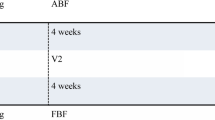Abstract
PURPOSE: This study was undertaken to assess the effect of biofeedback therapy in patients with constipation and paradoxical puborectalis contraction and to compare two different feedback modes. METHODS: Twenty-six patients were randomly allocated to either of two feedback modes: anal pressure using a manometry probe or anal sphincter electromyography (EMG) using surface electrodes. RESULTS: Six patients were unable to complete their training; ten patients were retrained using anal manometry and ten patients using EMG. The paradoxical puborectalis contraction disappeared after retraining with manometry feedback in eight of ten patients and with EMG feedback in ten of ten patients. A significant improvement in both bowel function and abdominal symptoms was found after training and a continued improvement at follow-up six months later. Six patients in the manometry group and nine in the EMG group experienced an overall improvement in symptoms. The two feedback methods did not differ in terms of efficacy. CONCLUSIONS: Our results suggest that biofeedback, using either manometry or EMG, is effective in improving symptoms and anorectal function caused by paradoxical puborectalis contraction.
Similar content being viewed by others
References
Kawimbe BM, Papachrysostomou M, Binnie NR, Clare N, Smith AN. Outlet obstruction constipation (anismus) managed by biofeedback. Gut 1991;32:1175–9.
Preston DM, Lennard-Jones JE. Anismus in chronic constipation. Dig Dis Sci 1985;30:413–8.
Kuijpers HC, Bleijenberg G. The spastic pelvic floor syndrome: a cause of constipation. Dis Colon Rectum 1985;28:669–72.
Wald A, Chandra R, Gabel S, Chiponis D. Evaluation of biofeedback in childhood encopresis. J Pediatr Gastroenterol Nutr 1987;6:554–8.
Loening-Baucke V. Modulation of abnormal defecation dynamics by biofeedback treatment in chronically constipated children with encopresis. J Pediatr 1990;116:214–22.
Turnbull GK, Ritvo PG. Anal sphincter biofeedback relaxation treatment for women with intractable constipation symptoms. Dis Colon Rectum 1992;35:530–6.
Weber J, Ducrotte P, Touchais JY, Roussignol C, Denis P. Biofeedback training for constipation in adults and children. Dis Colon Rectum 1987;30:844–6.
Wexner SD, Cheape JD, Jorge JM, Heymen S, Jagelman DG. Prospective assessment of biofeedback for the treatment of paradoxical puborectalis contraction. Dis Colon Rectum 1992;35:145–50.
Juan J, Nogueras J, Wexner SD. Biofeedback for nonrelaxing pubrectalis syndrome. Semin Colon Rectal Surg 1992;3:120–4.
Whitehead WE, Devroede G, Habib FI, Meunier P, Wald A. Functional disorders of the anorectum. Gastroentrol Int 1992;5:92–108.
Johnsson C, Nilsson BY, Mellgren A, Dolk A, Holmström B. Paradoxical sphincter reaction and associated colorectal disorders. Int J Colorectal Dis 1992;7:89–94.
Mahieu P, Pringot J, Bodart P. Defecography: I. Description of a new procedure and results in normal patients. Gastrointest Radiol 1984;9:247–51.
Kuijpers HC, Bleijenberg G, de Morree H. The spastic pelvic floor syndrome. Large bowel outlet obstruction caused by pelvic floor dysfunction: a radiological study. Int J Colorectal Dis 1986;1:44–8.
Lestar B, Penninckx F, Kerremans R. Biofeedback defecation training for anismus. Int J Colorectal Dis 1991;6:302–7.
Fleshman JW, Dreznik Z, Meyer K, Fry RD, Carney R, Kodner IJ. Out-patient protocol for biofeedback therapy of pelvic floor outlet obstuction. Dis Colon Rectum 1992;35:1–7.
Bleijenberg G, Kuijpers HC. Treatment of spastic pelvic floor syndrome with biofeedback. Dis Colon Rectum 1987;30:108–11.
Dahl JA, Lindquist BL, Tysk C, Leissner P, Philipson L, Järnerot G. Behavioral medicine treatment in chronic constipation with paradoxical anal sphincter contraction. Dis Colon Rectum 1991;34:769–76.
Siproudhis L, Dautreme S, Ropert A,et al. Anismus and biofeedback: who benefits? Eur J Gastroenterol Hepatol 1995;6:547–52.
Bull TL, Fazio VW, Schroeder T. Paradoxical puborectalis contraction in patients after pelvic pouch construction. Dis Colon Rectum 1995;11:1144–6.
Thompson WG, Creed F, Drossman DA,et al. Functional bowel disease and chronic functional abdominal pain. Gastroenterol Int 1992;5:75–91.
Neill ME, Swash M. Increasesd motor unit fibre density in the external anal sphincter uscle in anorectal incontinence a single fibre EMG study. J Neurol Neurosurg Psychiatry 1980;43:343–7.
Preston MD, Lennard-Jones JE, Thomas BM. The balloon proctogram. Br J Surg 1984;71:29–32.
Hinton JM, Lennard-Jones JE, Young AC. A new method for studying gut transit time using radio-opaque markers. Gut 1969;10:842–7.
Keighley MR, Shouler PJ. Abnormalities of colonic function in patients with rectal prolapse and fecal incontinence. Br J Surg 1984;71:892–5.
Ekengren K, Snellman B. Roentgen apperance in mechanical rectal constipation. Acta Radiol 1953;40:447–56.
Brodén B, Snellman B. Procidentia of the rectum studied with cineradiography: a contribution to the discussion of causative mechanism. Dis Colon Rectum 1968;11:330–47.
Mahieu PH. Barium enema and defecography in the diagnosis and evaluation of the solitary rectal ulcer syndrome. Int J Colorectal Dis 1986;1:85–90.
Komorowska E, Henrichsen S, Christiansen J, Hegedus V. Video-defecography combined with mearurment of the anorectal angle and of perineal descent. Acta Radiol 1987;28:559–62.
Bleijenberg G, Kuijpers HC. Biofeedback treatment of constipation: a comparison of two methods. Am J Gastroenterol 1994;89:1021–6.
Koutsomanis D, Lennard-Jones JE, Kamm MA. Prospective study of biofeedback treatment for patients with slow and normal transit constipation. Eur J Gastroenterol Hepatol 1994;6:131–7.
Wald A, Hinds JP, Caruna BJ. Psychological and physiological characteristics of patients with severe idiopathic constipation. Gastroenterology 1989;97:932–7.
Barnes PR, Hawley PR, Preston DM, Lennard-Jones JE. Experience of posterior division of the puborectalis muscle in the management of chronic constipation. Br J Surg 1985;72:475–7.
Yoshioka K, Keighley MR. Anorectal myectomy for outlet obstruction. Br J Surg 1987;74:373–6.
Hallan RI, Williams NS, Melling J, Waldron DJ, Womack NR, Morrison JF. Treatment of anismus in intractable constipation with botulinum A toxin. Lancet 1988;2:714–7.
Wasserman IF. Puborectalis syndrome (rectal stenosis due to anorectal spasm). Dis Colon Rectum 1964;7:87–98.
Author information
Authors and Affiliations
About this article
Cite this article
Glia, A., Gylin, M., Gullberg, K. et al. Biofeedback retraining in patients with functional constipation and paradoxical puborectalis contraction. Dis Colon Rectum 40, 889–895 (1997). https://doi.org/10.1007/BF02051194
Issue Date:
DOI: https://doi.org/10.1007/BF02051194




